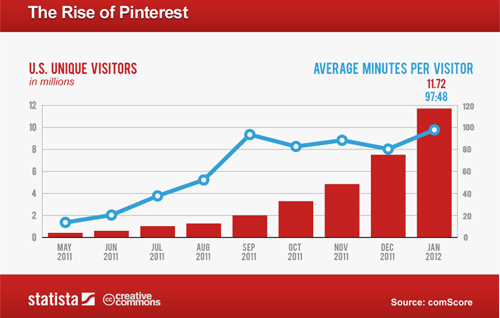 Pinterest's potential isn't an all-or-nothing proposition. But if you're a digital manager, you need a clear point of view on this for those you advise.
Pinterest's potential isn't an all-or-nothing proposition. But if you're a digital manager, you need a clear point of view on this for those you advise.
Yes, there's hype, but Pinterest is the front edge of at least two important digital marketing trends.
This is the first in a series of three posts taking a strategic view of what's shaping-up to be 2012's breakthrough new social network.
What's Pinterest?
Pinterest, in case you haven't heard of it, is Tumblr with some different features. Like Tumblr, it allows you to post your own stuff, as well as stuff you find around the internet, with the click of a button.
Where Tumblr is a blog variant, Pinterest lets you set up sub-blogs built around a particular interest or topic. So you can post all the cute pictures of pugs on one board and all the pictures about the economy on another. It also lets you search everyone else's boards easily.
That's really about it. One friend described it as "Delicious for pictures". Of course, delicious is text-driven and used by guys, while Pinterest is a scrapbook designed to drive relentless word-of-mouth referrals among women and apparently, Silicon Valley investors.
The size of Pinterest's splash
So why is there so much buzz around this? The numbers: The site beta-launched in March 2010 and is still invite-only.
Despite this, the user base surpassed 10m in December, and according to Google DoubleClick, now has 21m worldwide unique visitors per month.

Forrester analyst Darika Ahrens sums up Pinterest's allure below:
Pinterest is well known for having a demographic of 18-34-year-old, upper-income women from the Midwest - if that's not who you sell to, then Pinterest may not be for you,'' she said. "I'd ask, can you afford to be playing with pretty pictures when there are other, more urgent, interactive marketing priorities?'
Of course, as women make a huge range of purchase decisions for themselves and others (think travel, health care, home goods, food) having first-mover advertage can be an attractive proposition to many brands.
One of the things I appreciate about Pinterest is who uses it. When I look at the people I'm connected to on Google+, most of the posts I see are from a small number of tech-savvy 'early adopter' social media windbags.
They post a lot. But I don't see ordinary people on G+. Not as they are on Facebook, and Pinterest. There are many more ordinary people in this world. Unlike G+ and Twitter, Pinterest didn't have to jump a chasm to get to a majority market, its where they started.
And Pinterest is easy to use. Lots of people don't get Twitter, or the value of an unstructured stream of 140 character utterances. But organizing collections of inspiring images is a natural, even reflexive task. Its social media, but with only the need to curate images you like. That's a low barrier to participation.
The social media hype cycle is suggesting the solar system has a new axis called Pinterest. Is it wrong?
- SJ Mercury News: Pinterest, not Facebook, is Silicon Valley's hottest social network. (Guess it's too late to get in on Facebooks's IPO.)
- CNBC: "He credits the fast-growing site Pinterest for amplifying his online sales to 50 percent of his current business. On the site, he can let his art speak for itself." (Was it speaking for someone else on another site?)
- Tire Review (not making that up): Is Pinterest of Any Interest for the Tire Industry?
- There's already a service which claims to analyze one's influence through Pinterest.
- Heck, the U.S. Army has even put out a manual on using the site. (File under: You know you have too much money when…)
Is Pinterest for real?
This just has the feel of Color– remember Color? Less than a year ago it scored $41m of investment for its photo-sharing app from Sequoia and Bain Capital. And in social media it was everywhere — for all of two weeks.
Then everyone forgot about it after realizing its business model was the classic "Make something cool and hope Google buys it." (And believe me, I have nothing against that business model. All offers cheerfully considered, Mr. Brin.)
Pinterest's strategic role: TOFU Supreme
It turns out Pinterest is staking out a highly valuable position in the marketing universe.
Hannibal Lecter, the fantastic bad guy in Silence of the Lambs reminds us of a marketing truth when he asked his interrogator, "And how do we begin to covet, Clarice? Do we seek out things to covet? No. We begin by coveting what we see every day...Don't your eyes seek out the things you want?"
Before someone heads to Google to search with intent, they have to discover what they want. Sites like Pinterest start up to the Top of Funnel (TOFU) where sentiment gets formed.
Picture your friends making up lists right now of the best things they want. The list of the things they want can inspire others. If even a fraction of this demand can be directed to merchants, then there's a new conduit of demand, one that circumvents search. That's why marketers should care.
But the tide that brought attention to Pinterest can quickly shift. It would shift especially quickly if people start getting cranky about copyright issues. And then there are those pesky questions about Pinterest needing a business model.
So next we'll talk about the clever legal finesse behind Pinterest, which is what it takes to handle a potential copyright bomb.
No hay comentarios:
Publicar un comentario